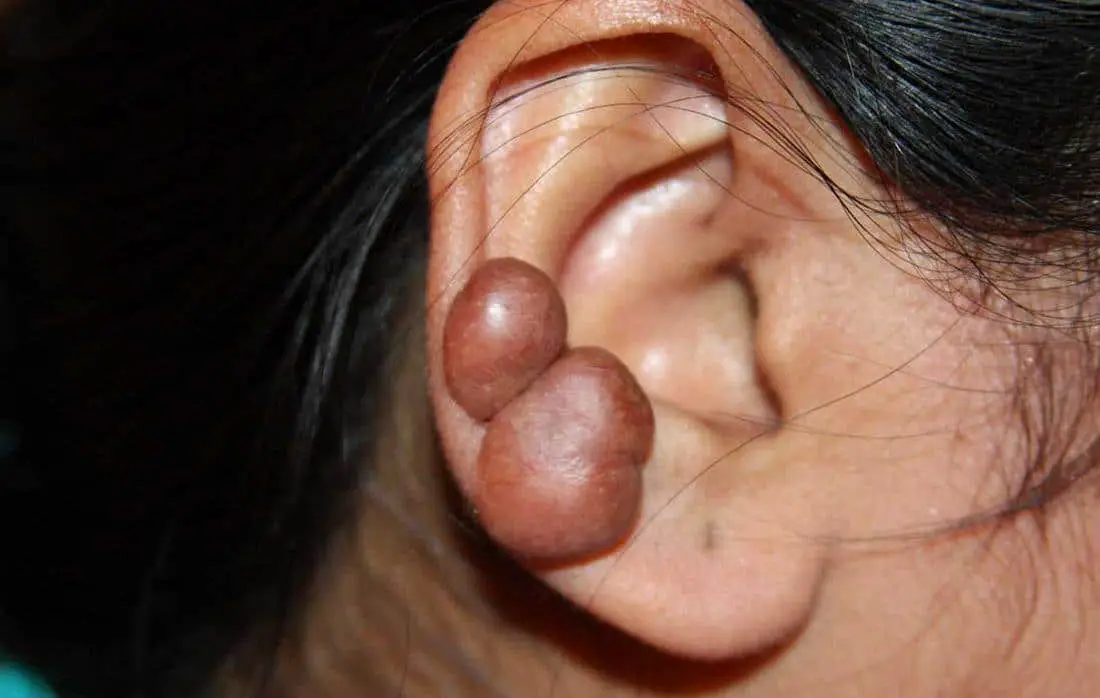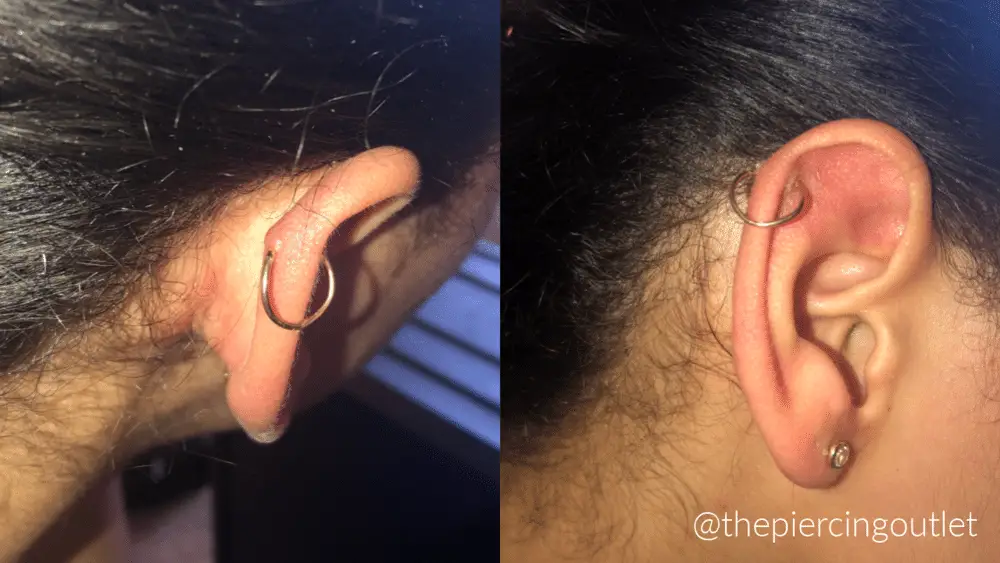Table of Contents
Cartilage Piercing Bump- Best Treatments And Prevention Strategies!
You may notice a cartilage piercing bump within the first few days of getting your piercings done. Cartilage pricing forms an open wound. It might appear lumpy, swollen, or like a tiny bump when it heals.
In the first few days following cartilage piercings, your body’s immune system triggers swelling and inflammation to heal the wound formed, sometimes leading to a cartilage pricing bump.
Over time, piercings might develop more bumps because of infection and scarring. In this article, you will learn more about a Cartilage Piercing Bump, its causes, treatments, and a few risk factors to note.
What is a cartilage piercing bump?

A cartilage piercing bump might be tiny and arise beneath the skin or so large that it alters the shape of your ear. Sometimes such bumps are painful and appear swollen or might further ooze pus. Other bumps can be simply painless.
Infected bumps require immediate treatment to stop the infection from circulating nearby. Some symptoms of the disease are as follows:
- The Cartilage piercing bump occurs soon after a piercing or after replacing the jewelry.
- A person develops a fever.
- The skin surrounding the bump hurts.
- The bump is red, tender, and painful.
- The bump is highly swollen and oozes pus.
Causes of cartilage piercing bump
Various issues may lead to the formation of a bump appearing on or around the cartilage piercing. A few of the most common causes are as follows:
1. Inflammation and irritation
A piercing is considered an open wound in your skin, and the hole it creates is a permanent scar. The therapeutic process of healing the scar can take a few months. During this time, your body’s immune system attempts to cure the wound to check bacterial infections.
Soon after a piercing, it is not uncommon to encounter some swelling, redness, or bruising. A swollen Cartilage piercing bump might form closer to the piercing.
2. Infections
When bacteria, fungus, or other dangerous microbes get inside the wound, they may cause an infection. A piercing is highly vulnerable to such an infection before it completely heals. Some infections are insignificant and heal on their own. Some infections, nevertheless, are painful and might spread to different areas of your body.
It is hard to tell how severe an infection is from signs alone, and not getting the proper treatment soon can generate complications. Some infections might even push your ear to become impaired, so people must talk to a doctor if they encounter any symptoms.
A person might have developed an infection if the cartilage piercing bump is:
- red
- painful
- swollen
- oozing pus
3. Pustule, or piercing blister
An abscess, also called a piercing blister, appears like a pimple on or adjacent to the piercing. It is a kind of localized infection. It is generally safe to manage these infections at home using frequent cleaning and warm compresses.
Often, these blisters go away and can be seen again. Visit a doctor if the bump happens to come back, if it is excruciating, or if numerous blisters emerge.
4. Granulation tissue
Granulation tissue is a different tissue that develops next to or over your recovering wound. It might look or feel like a tough lump or a blister. Picking at these tissues or removing them at home will cause an infection.
However, a doctor can clear the extra tissue with numerous in-office methods, such as silver nitrate or liquid nitrogen. In a few cases, a piercer might require redo the piercing, or a person might need to quit.
5. Keloid and hypertrophic scarring
Keloid and hypertrophic scars are big scars that arise after your wound has fully recovered. While anyone may notice these scars, people having darker skin appear more likely to have keloids.
Keloids are generally more extensive compared to hypertrophic scars. They may grow so enormous that they start itching or make it tough to move the area. Hypertrophic scars are comparatively more minor and might fade with time.
A doctor might reduce the size of the scar by freezing the scar off or injecting a corticosteroid. Keloids might get more prominently visible if the doctor performs surgery on them. As a result, surgery is not often a proper treatment.
6. Allergic reaction

An allergic reaction might cause cartilage piercing bump or inflame near the piercing. A person may see symptoms soon after the piercing or after changing the jewelry.
Allergic reactions might cause severe itching and pain. The wound might appear infected. Nickel is the most well-known cause of jewelry allergies and is ordinarily present in silver-plated or gold-plated jewelry. Swapping to surgical steel, certified, or hypoallergenic nickel-free jewelry might help solve this issue.
It would help if you swapped to something made with:
- 18-karat or 24-karat gold
- titanium
- stainless steel
- niobium
Treatments for cartilage piercing bump
The correct treatment for a cartilage piercing bump is based on the cause. Antibiotics can help fight bacterial infections. The doctor might suggest taking either oral pills or applying topical creams.
Like corticosteroid injections or cryotherapy, medical procedures might help with scarring or uncommon tissue growth.
A person who seems to have an allergic response might require to change their piercing jewelry. If the reaction is extreme, they might require to let the piercing fully heal over. Antihistamines, for example, diphenhydramine (Benadryl), might help if the irritation or itching is severe.
Here are a few things you can practice to treat or prevent a Cartilage Piercing bump.
1. Make sure you clean the piercing

It is essential to clean the piercing two or three times every day during the whole healing procedure. Even if the Cartilage piercing bump seems healed, you must still clean it each day for at least following three to six months.
Before touching the piercing for some reason, involving cleaning, clean your hands entirely using soap and warm water. Parch your hands using a paper towel before cleaning the piercing. It would help if you utilized an antimicrobial fragrance-free soap or the cleanser recommended by the piercer— to clean the piercing and the nearby area.
refrain from using:
- benzalkonium chloride (BZK)
- hydrogen peroxide
- iodopovidone (Betadine)
- rubbing alcohol
- chlorhexidine (Hibiclens)
Once you clean, rinse the area thoroughly. Any leftover soap can irritate. Dry the ear by delicately patting it using a paper towel. Cloth towels may be infected with bacteria and are highly likely to hook your earring.
2. Cleanse with a saline or sea salt soak
Saline soaks, and sea salt soaks function by rinsing away any unwanted and harmful bacteria that may cause an infection. They also clean away dead skin cells and other residues close to the piercing and develop keloids. Thus, help heal a Cartilage pricing bump.
If you do not wish to buy saline, you can create your own using sea salt. Saline is simply salt and water in precise mixed proportions.
You can make a solution by combining one-fourth teaspoon of acceptable sea salt with 8 ounces of warm water. Evade using larger crystals as they do not mix well in water and can become abrasive on the skin.
For soaking your ear:
- Load a cup to the brim with sea salt or saline solution.
- Lean your head down and keep your ear submerged. You can also sink a paper towel in this saline solution and apply it to the ear.
- Drown your ear for 5 minutes.
- Use a neat piece of paper to pat the area dry firmly.
3. Use a chamomile compress
Chamomile is famous for its potent anti-inflammatory properties and antioxidants. Using a warm chamomile compress, you can transfer its healing properties to your piercing while improving blood flow to your cartilage.
To create a warm chamomile compress, follow the steps:
- Clean your hands.
- Put a sachet of chamomile tea into warm water and let it steep for nearly five minutes.
- Use the tea bag to your piercing for nearly 5 to 10 minutes. You might want to refresh the tea sachet with warm water every few minutes.
- Once you’re done, clean your piercing and pat dry using a clean paper towel.
You can rotate between a saline soak and a chamomile compress. Just be mindful: You should not use chamomile if you hold a ragweed allergy.
5. Apply diluted tea tree oil

Tea tree oil is one of the most popular natural antifungal, antimicrobial, and antiseptic agents. Due to such properties, many people claim its ability to treat a Cartilage piercing bump.
If you wish to use tea tree oil on the cartilage piercing bump, you will have to dilute it first with the help of water or saline. You must also perform a patch test before using it.
To accomplish this:
- Use a small quantity of diluted tea tree oil on your forearm.
- Wait for 24 hours at least.
- If you do not undergo any inflammation or irritation, it must be safe to use it elsewhere.
After you’ve accomplished a successful patch test, you have a few options for how to combine tea tree oil with the cleansing routine. You can:
- Use any cotton swab to spread the diluted oil straight to the piercing one or two times a day.
- Add at least three to four drops of tea tree oil solution to the sea salt or saline soak.
Risk Factors

Anyone can grow a Cartilage piercing bump, though some people may be more vulnerable than others.
Risk factors are:
- a vulnerable immune system due to specific drugs, diabetes, or HIV.
- using contaminated jewelry or unsafe piercing approaches
- getting the piercing using a mall gun instead of using a needle by a licensed piercer
- having a record of keloid scars
- nickel and other related allergies
- a record of piercing issues.
Cartilage piercing bump- Prevention
A few strategies that may limit Cartilage piercing bump include:
- Choosing a good piercer- Make sure the piercer you choose is a licensed expert who sterilizes all the used pieces of equipment. Prevent utilizing ear-piercing guns, which are hard to clean and can disperse infection or damaged tissue.
- Keeping the piercing clean- Discuss with a doctor or piercer strategies to keep the piercing sterile. Avoid hydrogen peroxide, liquor, and other powerful chemicals, since they aggravate the piercing.
- Not constantly touching or picking at your piercing- Touching the piercing can distribute bacteria to the piercing, increasing the risk of infection. It might also damage the piercing, leading it to heal poorly.
- Avoid piercings if there is a prior history of keloids- People who grow keloids more easily are highly likely to develop large keloid scars after a piercing.
The Bottom Line
Most piercings recover without treatment, but minor irritation and difficulties are common. Rarely, a person might experience highly severe problems, such as harm to the ear or an ear’s systemic infection. It is crucial to keep your piercings clean and visit a doctor for signs of an infection.
Talk to an expert piercer about the correct piercing aftercare, then assiduously follow all the instructions. If the piercing grows more painful, swollen, or red and none of the home treatment help, seek medical care immediately.


